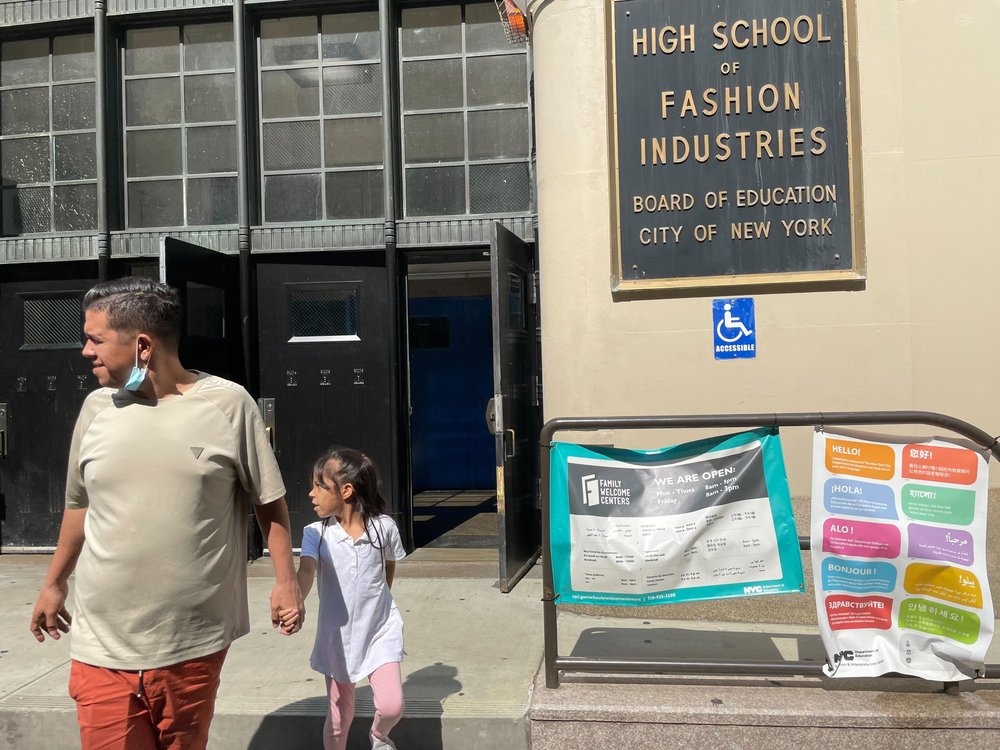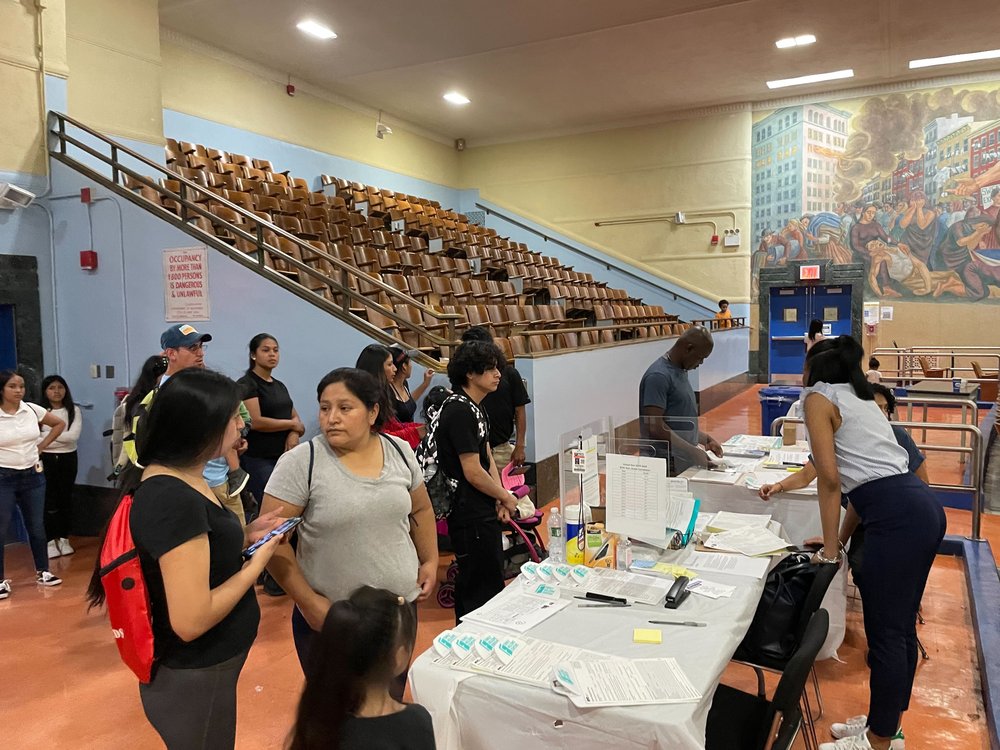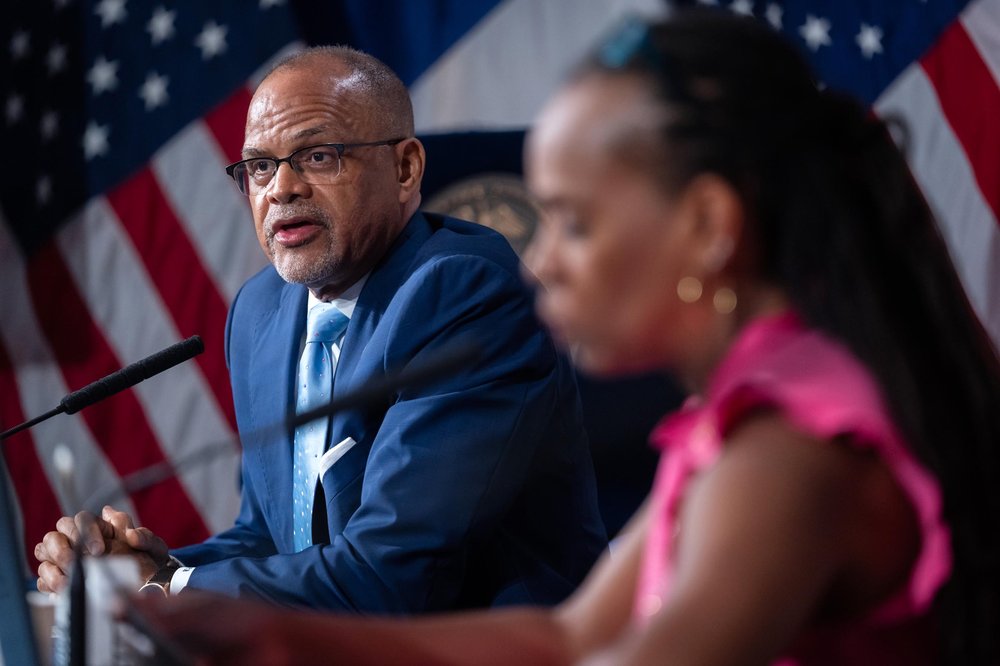Thousands of migrant students head to school in NYC for 1st time
Sept. 7, 2023, 5:01 a.m.
New migrant students keep enrolling every day. Last week, the city said nearly 19,000 suspected migrant students had entered the school system since last year. On Wednesday, that figure jumped to 21,000.

Thousands of migrant children will file into New York City public schools for the first time on Thursday – and new students keep showing up.
Last week, Adams administration officials said nearly 19,000 students – the vast majority of whom are presumed to be migrants – had enrolled in the public school system since last year. On Wednesday, education officials announced that that number had grown by 2,000. Some 2,500 new students enrolled just this summer.
“I have visited several of these schools that have welcomed these students. It is New York City Public Schools at its finest,” Schools Chancellor David Banks said at a press conference.
But he noted that the new arrivals had caused some “stress and strain” on the education system, and particularly on the city's finances.
Signs of the challenges were evident at an enrollment center at an auditorium inside the High School of Fashion Industries on Wednesday. Around 100 parents, most of whom did not speak English, waited to enroll their children in schools around the city.
Restless children cried and played with each other as their parents filled out paperwork so their kids could join the roughly 900,000 others headed to school the following day.

An education department employee familiar with the enrollment process said there aren't enough staff members to process all the new arrivals and added that the department is rushing to find them seats in classrooms. She said not all new students will have a spot in time for the first day of school.
“There are people waiting,” said the employee, who requested anonymity because she is not authorized to speak to the press.
Officials acknowledged that enrollment teams were short-staffed over the summer, but have picked up the pace in recent weeks. They said migrant students are being placed in schools with space near their shelters or are being sent to bilingual programs taught in their home language.
Melissa Aviles-Ramos, the education department official in charge of supporting migrant students, said “many of the schools have reached capacity.” So the department is trying to identify nearby schools with space.
Banks noted that overall enrollment in city schools has plummeted in recent years.
“We have room across our system,” he said. “We certainly don’t want to overwhelm any individual school.”
Parents and advocates have raised concerns about the concentration of migrants in high-poverty schools.
Officials said areas with the most migrant students so far include Midtown, Highbridge in the Bronx, and Corona, Queens.
As she stood outside the shelter at the Roosevelt Hotel on East 45th Street earlier this week, Jackeline Lamber said she was grateful to have just enrolled her two kids in public school after leaving their native Belize.
“It was difficult at first because … I had to be on a waiting list for pre-K,” she said. Ultimately, though, she was able to enroll her two children together. “It’s better for me to have them at the same school,” she said.
But communication in the classroom is likely to remain a challenge once students are in school. Last year, teachers who spoke only English used translation apps on their phones to try to get basic information across to students who spoke only Spanish, Ukrainian or Russian, Gothamist reported.
Last year, there were roughly 5,500 bilingual teachers and teachers of English as a new language serving 150,000 English-language learners in the city's school system. Banks said the city has hired hundreds more in recent months.

Schools Chancellor David Banks praised school communities for their response to new migrant students.
But Michael Mulgrew, president of the United Federation of Teachers, said more bilingual educators are needed.
"We know we do not have enough teachers who speak all of the different languages,” said Mulgrew. “Some of these languages that some of the students are speaking we have never had before in New York City."
He said the state education department should make it easier for teachers to get certified as bilingual educators. “It shouldn't be so onerous anymore, there's an emergency crisis,” he said.
Meanwhile, school communities are mobilizing to meet the needs of new students, who often arrive having missed months or even years of education while enduring physical and mental trauma on an arduous journey to the U.S.-Mexico border.
Parent Kate Menken helped distribute backpacks at I.S. 145 in Jackson Heights on Tuesday. She said local elected officials donated 450 backpacks, which were snapped up within 45 minutes. She said her school, which has a robust bilingual program, enrolled hundreds of migrant students last year.
Parent Mashura Akilova said her child’s school – P.S. 145 on West 105th Street – enrolled around 120 immigrant students from nearby shelters last year.
She said the school, which already had dual language programs in Spanish and Russian, was a natural destination for the new students.
“We are committed as a community to not denying education to anyone who comes through the doors,” Akilova said, adding that the principal did not want to turn families away.
Educators and parents sprang into action.
Parents began fundraising for school and hygiene supplies early in the previous school year. Then they started helping wash migrant students’ laundry and successfully petitioned the education department to install laundry machines at the school itself. Some families invited the newcomers to their homes for hot meals. The school hosted a special Thanksgiving dinner for the families at a nearby synagogue in November.
“You start with the basic needs,” she said.
But Akilova said the school is now overenrolled and overcrowded. Some students now have to get speech help or physical therapy in the cafeteria and stairwells. Dedicated rooms for science and music have been converted into regular classrooms to accommodate the growing student body.
Fellow P.S. 145 parent Naveed Hasan said the education department must do more to give schools the space and resources they need.
“It’s a very bottom-up approach,” he said. “We’re running out of volunteers.”
Ramsey Khalifeh contributed reporting.
This story has been updated to correct the spelling of Naveed Hasan's last name.